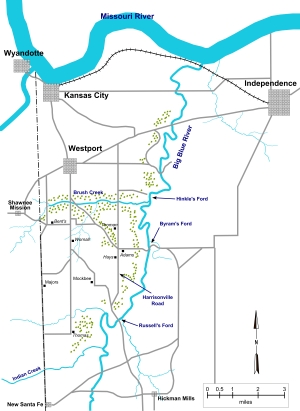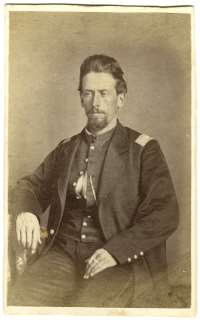Search:
Powered by
Website Baker
Battle of the Big Blue, October 22, 1864
|
Regional map of Westport and vicinity based on OR Atlas Plate 66, Map 3 |
After Blunt’s cavalry had fallen back from the fight at the Little Blue River, they refitted and entered the defense line along the Big Blue River. Manning the Federal defenses at Byram’s Ford was Colonel Charles R. Jennison, Fifteenth Kansas Cavalry. Jennison had about 1,000 men to defend the ford, consisting of Federal volunteer cavalry and some units from the Kansas State Militia. Major General Samuel R. Curtis was confident his defense line along the Big Blue River was a strong one. The Federals stretched over 15 miles from the mouth of the Big Blue River all the way up to Russell’s Ford. Captain Henry E. Palmer, Company A, 11th Kansas Cavalry, described their work to improve the defenses on the west side of the river.
"On October 22 our command was employed cutting timber and constructing abatis work, blocking the roads and trails and all the crossings of the Big Blue from its mouth to Byram's ford, and south of that point a mile or more."
The Confederates attacked but were unsuccessful in getting across at Byram’s Ford. Shelby detached some of his cavalry to scout upstream and downstream in order to find another way across. They did and soon Colonel Jennison found his position flanked by the enemy. Jennison ordered his men to pull out and they retreated west, fighting the whole way.
|
Charles R. Jennison courtesy of the Wilson's Creek National Battlefield, National Park Service |
Colonel Thomas Moonlight was defending the crossing at Hinkle’s Ford, about 1.5 miles downstream from Jennison’s position. When Moonlight realized what was happening to Jennison, he withdrew west to reinforce Jennison. By the time Moonlight caught up, Jennison had been pushed back almost five miles to the Kansas state line. As darkness fell, Moonlight and Jennison were able to push the Confederates several miles east. Jennison described the engagement in his official report.
"On the morning of the 22d I was ordered with the brigade to Byram's Crossing of the Big Blue … About 11 a.m. the enemy's advance made its appearance at the ford, attacking our outposts and attempting to force a crossing. The ford was so effectually obstructed, however, and in its condition wholly impassable for artillery, that for some hours little progress was made, the attacking party being repulsed each time it appeared in the front … about 3 p.m., when it became evident that [the enemy] had succeeded in crossing considerable bodies, both above and below, and was rapidly flanking us both on the right and left … [I] determined to retire in the direction of Westport … contesting every foot of ground until the enemy gave over the action and retired to the ford."
Brigadier General M. Jeff Thompson wrote in his official report about his fight against the Federals.
"On the 22d we left Independence at 9 a.m. and took the road to Westport. We were … ordered to take a left-hand road and push for the Big Blue River to force a crossing south of the main crossing. We soon reached the point indicated and found that the enemy had obstructed the crossing by felling trees, and were disposed to dispute our passage. A portion of the brigade were dismounted, and in the face of the enemy waded the stream and made a lodgment upon the west bank. Others soon followed, and we drove the enemy so fast that the axes they had used to fell the trees were left by them, and they were speedily put to use in opening a road for our artillery and the train to cross."
Once his defenses had been breached at Byram’s Ford, Major General Samuel R. Curtis issued order to withdraw from the Big Blue River and fall back to the defenses in Kansas City. His army of over 15,000 men, who had been on a north/south line facing east, had to pivot to a line running east/west facing south.
Major General Sterling Price had achieved his first objective. He had control of Byram’s Ford and sent orders to get his wagon train on the move.

